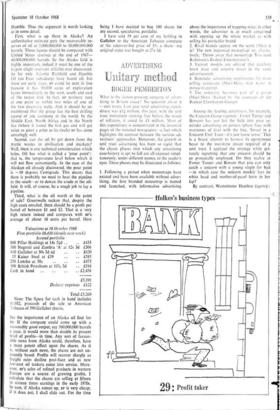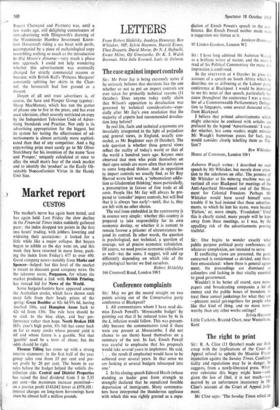Unitary method
ADVERTISING ROGER PEMBERTON
What is the fastest-growing category of adver- tising in Britain today? No question about it —unit trusts. Last year total advertising expen- diture was £11 million; this year, with the unit .trust movement running free before the winds of inflation, it could be £3 million. Most of this expenditure is concentrated in the financial pages of the national newspapers—a fact which highlights the contrast between the various ad- vertisers' approaches. Moreover, the growth in unit trust advertising has been so rapid that the classic phases into which any advertising case-history is apt to fall are all exposed simul- taneously, under different names, to the reader's eyes. These phases may be illustrated as follows: 1. Following a period when mousetraps have existed and have been available without adver- tising, the first branded mousetrap is named and launched, with informative advertising
about the importance of trapping mice; in other words, the advertiser is as much concerned with opening up the whole market as with selling his particular brand.
2. Rival brands appear on the scene ('Ilere it is! The new improved mousetrap' or, alterna- tively, 'Throw away that mousetrap. You need Robinson's Rodent Exterminator').
3. Variant models are offered (for catching town mice and country mice) in the same advertisement.
4. Reminder advertising supplements the main selling campaign (Nturi-Mors—first name in mouse-trapping).
5. The company becomes part of a group (Muri-Mors—backed by the resources of the Rodent Elimination Group).
Among the leading advertisers, for example, the Unicorn Group (agency : Foster Turner and Benson) has just led the field into pure re- minder advertising on posters (phase four with overtones of five) with the line, 'Invest in a Unicorn Unit Trust—it's just horse sense.' This is a brave attempt to harness its eponymous beast to the mundane image required of a unit trust. I applaud the strategy while pri- vately regretting that any unicorn should be so prosaically employed. Do they realise at Foster Turner and Benson that you can only catch a unicorn with a young virgin for bait —in which case the unicorn meekly lays its white head and mother-of-pearl horn in her lap?
By contrast, Westminster Hambro (agency:
Rupert Chetwynd and Partners) was, until a few weeks ago, still delighting connoisseurs of non-advertising with Illingworth's drawing of the Westminster Hambro Investment Know- how Hovercraft riding a sea beset with perils, accompanied by a piece of eschatological copy resembling nothing so much as the introduction to Old Moore's Almanac—very much a phase one approach. I could not help wondering whether this advertisement was eventually changed for strictly commercial reasons or because, with British Rail's 'Princess Margaret' constantly splitting her skirts in the Chan- nel, the hovercraft had lost ground as a mascot.
Doyen of all unit trust advertisers is, of course, the Save and Prosper Group (agency: Sharp MacManus), which has run the gamut of phases one to five in the press, and has even used television, albeit severely restricted on copy by the Independent Television Code of Adver- tising Standards and Practice. Not only is its advertising appropriation far the biggest, but its system for testing the effectiveness of ad- vertisements is almost certainly more sophisti- cated than that of any competitor. And a big copywriting prize must surely go to Mr Oliver Stutchbury for his invention of the name 'Save and Prosper,' uniquely calculated at once to allay the small man's fear of the stock market and to identify the 'product' as the Easily Ob- tainable Nonconformist Virtue in the Handy Unit Size.







































 Previous page
Previous page